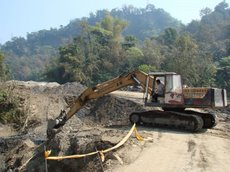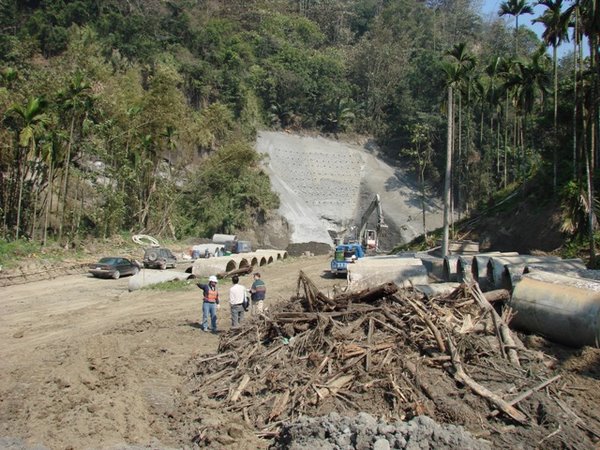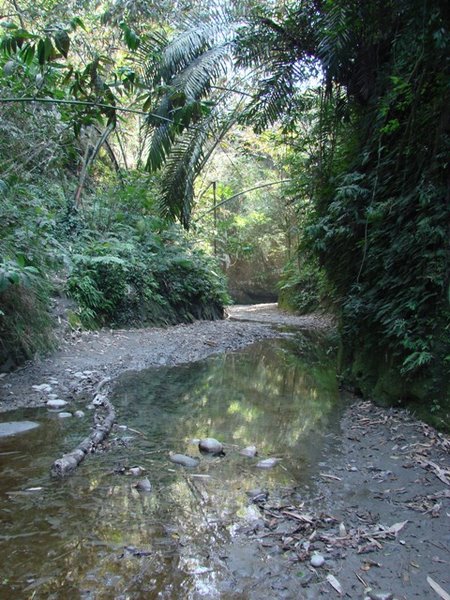One of the major criticisms and concerns over the Hushan Dam project is that the dam will just silt up and become unusable within a very short period. After the devastating earthquake in September 1999 the general area remains highly unstable. Obviously there is a major safety concern with a large dam being constructed in an unstable area that is within an area with an alarming history of earthquakes. If the dam wall fails a lot of people will be in very big trouble.
Lets put aside the safety concerns for a moment and lets just look at the silt issue. It is a known fact that after the big 921 Earthquake in September 1999 large amounts of debris and silt were deposited in the middle and lower reaches of the the Chingshuei River. Silt, large boulders and other flood debris are frequently deposited in the mid and lower reaches after typhoons. Taiwan is usually struck by several typhoons (three to five typhoons on average) each summer. A large lake has formed on the Chingshuei River in the Tsaoling area five times over the past century as a result of debris from earthquakes, typhoons or landslides blocking the channel of the river. The most recent was as a result of the big 1999 earthquake. This lake rapidly silted up and what was left was destroyed by a typhoon in 2005 which resulted in large amounts of silt and flood debris being deposited further downstream. The Jiji weir on the Jhoushuei River within the same area suffers from a major silt problem.
The catchment area for the Chingshuei River is geologically highly unstable as a result of the big 921 Earthquake. With the impact of Typhoon Morakot the area has one again suffered extensive damage. Mountainsides are exposed and scared by landslides and as typhoons hit the area over the next few years it is a certainty that many exposed slopes will come crashing down into the Chingshuei River. Route 149, which largely follows the course of the Chingshuei River has been destroyed. Numerous bridges along the route have been washed away and damaged. Whole sections of the road have been washed away or covered by landslides and flood debris. It will take years to repair the damage. It should be noted that parts of this route were still being repaired as recently as 2006 following the 921 Earthquake.
The big question is why with all this proof are we still trying to build the Hushan Dam? How much proof do we still need before we admit Hushan Dam is an idiotic idea? The forces of nature through earthquakes and typhoons keep reminding us what they do to the Chingshuei River. The government's own Environmental Protection Administration's Environmental Impact Assessment Committee ruled the construction of Hushan Dam illegal. Developers have said the ruling was non-binding and just forged ahead with the project with the backing of the authorities. The fact that the issue still lies before the courts and the courts have yet to rule on the legality of the project have just been brushed aside. The only people that stand to benefit from the construction of the Hushan Dam are the developers. For the people of Taiwan they are undoubtedly funding a highly dangerous and costly white elephant with their tax dollars and stand to gain nothing except more expenses in repairing the damage that the Hushan Dam has and will cause to Taiwan's natural environment.
A series of photos showing some of the devastation to the Chingshuei River valley and Route 149 just upstream of the village of Tsaoling. 













Also see:
Typhoon Morakot: The Writing's on the Wall
Air quality worsens from Typhoon Morakot's dust
Taiwan's Aborigines Suffer More Than Morakot
Monday, September 14, 2009
The proof of the pudding is in the eating: The Chingshuei River after Morakot
Posted by
Wild at Heart Legal Defense Association
at
10:30 AM
![]()
Subscribe to:
Post Comments (Atom)

















No comments:
Post a Comment